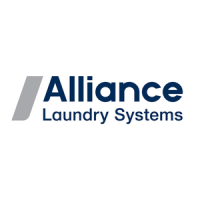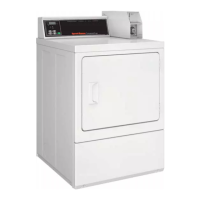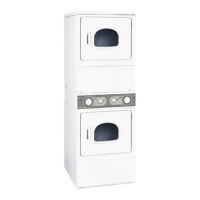Do you have a question about the Alliance Laundry Systems JTB50CG and is the answer not in the manual?
Key precautions to minimize risks of fire, shock, injury, or death when using the tumbler.
Critical warnings about potential hazards and the importance of common sense and caution.
Provides general information, manual scope, and reference details for tumbler models.
Details on locating the nameplate and information for ordering replacement parts.
Specifies overall cabinet dimensions for various tumbler models.
Details the location and size of exhaust thimbles for different tumbler models.
Specifies the location and size of steam inlet and outlet connections for tumblers.
Details the location and size of gas connections for various tumbler models.
Specifies the location of electrical service connections for gas, steam, and electric tumblers.
Detailed specifications for 30 lb gas, electric, and steam tumblers.
Detailed specifications for 50 lb gas, electric, and steam tumblers.
Detailed specifications for 75 lb gas, electric, and steam tumblers.
Detailed specifications for 120 lb gas and steam tumblers.
Detailed specifications for 170 lb gas and steam tumblers.
Procedures for inspecting the delivered tumbler and listing required local materials.
Guidelines for correctly placing and leveling the drying tumbler on its installation site.
Requirements for tumbler enclosures, floor, layout, venting, and make-up air.
Guidelines for proper tumbler venting, duct sizing, and ensuring adequate make-up air supply.
Essential warnings regarding gas connection, fire, and explosion risks.
Details on required gas pressure and pipe sizing for optimal and safe operation.
Illustrative examples of gas loop and supply piping configurations for different tumbler capacities.
Guidance on steam line sizing, piping configurations, and trap installation.
Procedures for installing steam solenoid valves, inlet connections, and condensate return lines.
Specific steam pressure, pipe diameter, and trap size requirements for 30, 50, 75, 120, and 170 lb models.
Critical safety warnings, grounding instructions, and connection requirements.
Instructions for jumper configuration and ring ferrite installation for OPL models.
Detailed electrical specifications including voltage, current, breaker, and wire size for different tumbler capacities.
Steps for installing new timing cams and removing existing ones for coin meter models.
Steps to perform before the first operation, including safety and system checks.
Procedures for verifying proper operation of manual, coin-operated, and OPL control tumblers.
Explains the function of status lights, signals, and the reversing pad on the control panel.
Guidance on selecting fabric types and different cycle modes like Automatic, Time Dry, and Custom.
Information on locking controls, adjusting temperatures, and checking the temperature sensor.
Guide for adjusting the air shutter for optimal burner flame and combustion.
Instructions for adjusting air flow switches and understanding the air flow light indicator.
Procedures for adjusting the cylinder door switch, activator, and door strike for proper function.
Steps for adjusting belt and chain drive tension for non-reversing and reversing models.
Step-by-step guide for operating the manual dual timer tumbler.
Instructions for operating coin-operated tumblers, including coin drop and electronic control models.
Explanation of the reversing function and how to use the reverse control switch.
Guide for operating tumblers with OPL micro-control panels, including cycles and settings.
Procedure for cleaning the lint screen and compartment to ensure proper airflow.
Includes lubrication, belt tension checks, and cleaning air vents.
Scheduled checks for steam coils, exhaust ducts, connections, and overall tumbler condition.
Recommendations for efficient tumbler operation to save energy and reduce costs.
Identifies common problems like air flow restrictions, gas issues, and voltage requirements.
| Brand | Alliance Laundry Systems |
|---|---|
| Model | JTB50CG |
| Category | Dryer |
| Heat Source | Gas |
| Amperage | 15 A |
| Type | Commercial |
| Capacity | 50 lb |
| Energy Source | Gas |












